|
|
|
Sort Order |
|
|
|
Items / Page
|
|
|
|
|
|
|
| Srl | Item |
| 1 |
ID:
112436


|
|
|
|
|
| Publication |
2012.
|
| Summary/Abstract |
This paper identifies imaginings since the early 1990s to reposition Yunnan from a peripheral province in the PRC to the centre of various regional constructs which involve territories across the PRC's borders, primarily in what are now known as southeast and south Asia. These narratives, which change over time and between actors, are justified using Yunnan's past linkages with territories along the 'southern silk road' and through a naturalized presentation of its geographical location and characteristics, are based on the premise of good neighbourly relations, and are driven by imperatives of development. They find practical expression in provincial engagement with regional institutions, and in infrastructure and other programmes. However, the imaginings to reposition the province which these narratives spell out are at the same time constrained by the demands of territorial integrity and national security: a desire not to compromise Yunnan's national belonging. The paper concludes by commenting on implications for understanding 'China's borderlands' and their global interactions.
|
|
|
|
|
|
|
|
|
|
|
|
|
|
|
|
| 2 |
ID:
139172
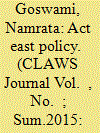

|
|
|
|
|
| Summary/Abstract |
For many years now, since 1992, when it laid its seed and slowly gathered momentum in policy circles, the “Look East” policy has been oft repeated in New Delhi’s strategic and policy circles as one of India’s foremost long-term policy visions to open up its economy for investment and trade with Southeast Asia. Increasingly now, the reference has changed from “Looking East” to “Acting East” by which one would expect that the policy is in its implementation phase. In augmenting the “Act East” policy, the northeast of India emerges, by the criterion of geography, as the region which will act as the ‘strategic catalyst’ or ‘game changer’ in accomplishing the vision that the policy aspires to embolden. Situated between China, Bhutan, Bangladesh, and Myanmar and with an international border stretching up to 4, 500 km, the region has held the promise of acting as a bridge between India and Southeast Asia for years. Its history vindicates such a role as its people have traded and travelled across the Southeast Asian region and Yunnan for years through the ancient Silk Road, trading in Himalayan salt, spices, handicrafts, food items, silk and other goods. This region witnessed migration of people from Southeast Asia and Yunnan to Assam and its surrounding hills, the most prominent being the Ahoms tracing their roots to the Tai race in Yunnan and Thailand. The Ahoms led by Sukapha arrived in Assam in
1228 A.D. and ruled over this region for 600 years. It is significant to note that the Ahoms under Lachit Borphukan successfully prevented Mughal expansion into Assam by defeating the Mughal Army in the much revered Battle of Saraighat of 1671.1
|
|
|
|
|
|
|
|
|
|
|
|
|
|
|
|
| 3 |
ID:
126046
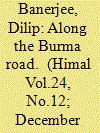

|
|
|
|
|
| Publication |
2011.
|
| Summary/Abstract |
Yunnan was one of the worst-hit areas during World War II, almost completely destroyed by Japanese bombing. By today the province has been rebuilt, however, and the old Burma Road - that icon of the war, used to transport support material for the Allies into China - has been upgraded into a six-lane highway. Once it crosses the Chinese border, however, this potentially lucrative land link between China and India falls into disrepair, despite years of plans to upgrade it. On the Indian side, the Ledo Road (or Stilwell Road, after an American general), links up to the Burma Road, and is indeed motorable. But it too falls into disrepair on the Burma side.
|
|
|
|
|
|
|
|
|
|
|
|
|
|
|
|
| 4 |
ID:
129685
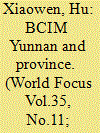

|
|
|
|
|
| Publication |
2014.
|
| Summary/Abstract |
BCIM (Bangladesh, China, India and Myanmar) forum for regional cooperation was jointly initiated by think tanks of China and India at the end of 1990s. on August of 1999, the first conference was held in Kunming and announced Kunming initiative, which opening the exploration of BCIM forums were convened persistently and alternately from 1999-2013 among four countries.
|
|
|
|
|
|
|
|
|
|
|
|
|
|
|
|
| 5 |
ID:
177673
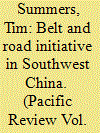

|
|
|
|
|
| Summary/Abstract |
The Belt and Road Initiative (BRI) has been the subject of extensive analysis since late 2013. Most of this views it as a manifestation of China’s approach to global issues under Xi Jinping, whether economic, geopolitical, or as a bid to reshape globalization. There has so far been less research into the domestic dynamics of the BRI, including at the sub-national level in China. Based primarily on an examination of provincial-level policy documents and research, this paper explores the ways in which policy makers in the southwestern province of Yunnan have responded to the BRI, and what this might mean for the implementation and shaping of the initiative. It identifies the promotion of externally-oriented development as the main response in Yunnan to the BRI, structured around the idea of making the province a ‘pivot’ to south and southeast Asia. This provincial-level response is shaped by pre-existing policy goals in Yunnan and reflects more continuity than change in policy substance. This is consistent with interpretations of the BRI as an ‘omnibus’ policy which can incorporate multiple objectives and act as a framework within which provincial actors can compete for influence or which they can use to make progress towards achieving local objectives in the context of national strategy. The paper concludes that in the case of Yunnan and the BRI, broad alignment between provincial and central government objectives suggests that on this issue, Yunnan is more of an ‘influencer’ and ‘interpreter’ than ‘ignorer’ of national policy goals.
|
|
|
|
|
|
|
|
|
|
|
|
|
|
|
|
| 6 |
ID:
113712


|
|
|
|
|
| Publication |
2012.
|
| Summary/Abstract |
Yunnan, a southwestern frontier province in China is located in mainland Southeast Asia and is inhabited by diverse cross-regional ethnic groups. This essay attempts to reveal the Bengal connections in historical Yunnan from the medieval age to the early modern period through a scrutiny of Chinese and certain non-Chinese sources. It first discusses the use of cowry currency in Yunnan and other areas around the Bay of Bengal, and then constructs historical routes linking the Bengali world and Yunnan, both by land and sea. Furthermore, the spread of Buddhism into Yunnan is highlighted to demonstrate Bengali cultural influence. The Bengal connections in Yunnan hence, shed some light on both historical Yunnan and the formation of Chinese frontiers.
|
|
|
|
|
|
|
|
|
|
|
|
|
|
|
|
| 7 |
ID:
167075
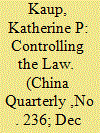

|
|
|
|
|
| Summary/Abstract |
Millions of China's ethnic minority citizens remain subject to competing legal standards, even as state officials strive to strengthen a unified notion of state law. Minority customary law continues to bind many minority citizens in both civil and criminal arenas and often conflicts directly with state law. What happens when these laws conflict? Based on fieldwork in Yunnan, this article shows how local officials and communities navigate legal pluralism and what legal and policy provisions guide them. Granting local judges discretionary authority to set aside state law in favour of customary law, although seemingly undermining law enforcement, may in the long run be the best path to strengthening rule of law in China's minority regions.
|
|
|
|
|
|
|
|
|
|
|
|
|
|
|
|
| 8 |
ID:
181903


|
|
|
|
|
| Summary/Abstract |
Authenticity is a concept that is not seen in UNESCO’s Intangible Cultural Heritage (ICH) discourse but is emphasised in Chinese ICH official discourse. An analysis of the origins, discourses, and practices of the notion of authenticity of ICH, as well as the difficulties generated from this concept, illustrates the creation of ICH in China, which mediates between local and international ideologies. This paper adopts historical and critical heritage discourse perspectives to examine cases in Yunnan Province, China, including the understandings, discourses, and practices of the idea of “authenticity” and related original ecology in regard to experts, officials, and ICH practitioners. Through the lens of authenticity, the paper illustrates the history of the complicated relationships between authenticity and ICH in the last 20 years, revealing the dynamism and difficulties in the integration of authenticity and ICH as an official discourse, and the possibilities and restrictions of reconceptualising authenticity in the current contexts of integrating culture and tourism, as well as the reform of cultural governance, in contemporary China.
|
|
|
|
|
|
|
|
|
|
|
|
|
|
|
|
| 9 |
ID:
053657
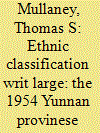

|
|
|
| 10 |
ID:
097888
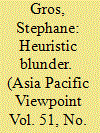

|
|
|
|
|
| Publication |
2010.
|
| Summary/Abstract |
During long-term fieldwork the increasing involvement of the ethnographer in the lives of others raises a series of methodological and ethical issues. These can become even more pronounced when one is working with ethnic minorities in a socialist country. Yet, a seldom acknowledged reality of ethnographic fieldwork experience are the 'little failures' that occur along the way, alongside ethnographic blunders. I argue that these are difficult to avoid and can be part of an important learning process, oftentimes for both researcher and researched. Through the detailed description of a blunder that the author made during his research in southwest China with members of the Drung ethnic minority, this article advocates for the heuristic value of such mishaps, suggesting that one can learn a lot from accidents and unexpected events while undertaking in-depth ethnographic fieldwork. In this case, this helped to shed light on the micropolitics of Drung village life in southwest Yunnan, and the place of a 'minority nationality' in wider Chinese society.
|
|
|
|
|
|
|
|
|
|
|
|
|
|
|
|
| 11 |
ID:
161260


|
|
|
|
|
| Summary/Abstract |
Most analyses of China's foreign and security policies treat China as a unitary actor, assuming a cohesive grand strategy articulated by Beijing. I challenge this conventional wisdom, showing how Chinese provinces can affect the formulation and implementation of foreign policy. This contributes to existing research on the role of subnational actors in China, which has focused on how they shape domestic and economic policies. Using Hainan and Yunnan as case studies, I identify three mechanisms of provincial influence – trailblazing, carpetbagging, and resisting – and illustrate them with examples of key provincial policies. This analysis provides a more nuanced argument than is commonly found in international relations for the motivations behind evolving and increasingly activist Chinese foreign policy. It also has important policy implications for understanding and responding to Chinese behaviour, in the South China Sea and beyond.
|
|
|
|
|
|
|
|
|
|
|
|
|
|
|
|
| 12 |
ID:
116567
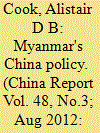

|
|
|
|
|
| Publication |
2012.
|
| Summary/Abstract |
Over the past two decades there has been increasing international attention to the interactions between Myanmar and China. While China has significant influence in relation to other international actors, there is also significant calculation by the government in Myanmar in an effort to ensure that no single external actor calls the policy shots. Instead, the policy choices of the government illustrate that they are calculated on a case-by-case basis to respond to emerging security threats and challenges. However, this represents only a partial truth because there are myriad actors competing for legitimacy in Myanmar which also have various relationships with external actors. Indeed, to fully understand the relationship between Myanmar and China a multifocal lens is required to appreciate the nuances and tensions within Myanmar and their effects on its overarching relationship with China. Furthermore, this lens must also be applied to China, as it too has multiple levels of engagement with Myanmar at both formal and informal levels to varying degrees. This article analyses this complex web of interactions to provide insight into the various agendas, strategies and challenges at play in the relationship between Myanmar and China.
|
|
|
|
|
|
|
|
|
|
|
|
|
|
|
|
| 13 |
ID:
053659
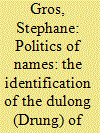

|
|
|
| 14 |
ID:
099701
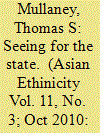

|
|
|
|
|
| Publication |
2010.
|
| Summary/Abstract |
This article proposes a new understanding of the Ethnic Classification project (minzu shibie) undertaken in China's southwesternmost province of Yunnan in 1954 - a project in which social scientists and Communist Party cadres set out to determine which of the dozens, if not hundreds, of minority communities in the province would be officially recognized by the state. Specifically, this article argues that ethnologists and linguists played a far greater role in the Classification and early Chinese Communist governmentality than is typically assumed. The Chinese Communists did not teach themselves how to 'see like a state,' to use James Scott's formulation, at least not when it came to the fundamentally important problem of ethnic categorization. To the contrary, the history of the Classification project is one of an inexperienced Chinese state that was able to orient itself only by observing the world through the eyes of its social scientific advisors. The 'mentality' within early Chinese Communist Party (CCP) 'governmentality' was, in the case of the 1954 Ethnic Classification, in large part the mentality of the comparative social sciences.
|
|
|
|
|
|
|
|
|
|
|
|
|
|
|
|
| 15 |
ID:
178465


|
|
|
|
|
| Summary/Abstract |
Commodity crops are redefining land use and rural smallholder livelihoods across Asia. These crops often have boom-bust cycles with important implications for the drivers of farmer entry into and exit from particular cash crop opportunities. This paper offers a comparative analysis of the boom-bust processes of three popular spice crops cultivated in Yunnan Province, southwest China. Drawing from agrarian frontiers and rural livelihoods literature, we disentangle the vulnerability contexts associated with black cardamom, cinnamon and star anise production, finding that farmers cultivating these spices face a combination of interlocking forms of vulnerability. Despite the monetary potential that each crop offered during its ‘boom’, the associated environmental, economic and political vulnerabilities caused most farmers to exit their production, responding with myriad on-farm and off-farm diversification strategies. Using a multi-sited ethnographic approach, we draw on 52 in-depth interviews with ethnic minority cultivators, spice traders and local government officials to untangle the complexities associated with cash crop production in this agrarian frontier, the interwoven vulnerabilities that result in their ‘busts’ and the coping and adaptation strategies that smallholder farmers employ. Our findings underline the importance of disaggregating farmer vulnerabilities and the need for more nuanced policy responses to adequately support small-scale farmers.
|
|
|
|
|
|
|
|
|
|
|
|
|
|
|
|
| 16 |
ID:
180651
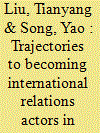

|
|
|
|
|
| Summary/Abstract |
While Chinese paradiplomacy has received growing academic attention, little is known about how different provinces within China act as international relations players of their own accord. This paper adopts a comparative perspective to address this gap. It develops three dimensions of international actorness (authority, motivation, and instruments) to examine whether and how Chinese provinces have satisfied the criteria for being international relations actors through their engagements in the Belt and Road Initiative (BRI). Using Guangdong and Yunnan as examples, this paper casts light on the plural occasions in which the de-centralized state control of foreign affairs and the growing external activism of provincial entities have worked in tandem to widen the footprints of said provincial entities in the countries of the BRI. Drawing on Guangdong-Hong Kong competition and Yunnan-Guangxi rivalry, this paper unpacks the motivations of provincial engagements in the BRI by exploring the utility of imitation tactics used to gain comparative advantages vis-à-vis their domestic counterparts. While comparing the Guandong and Yunnan’s leveraging of strategic instruments, this paper also reveals Guangdong’s strong globalist, mercantile mentality in its external interactions, in contrast with the more regionalist and stability-oriented approach of Yunnan.
|
|
|
|
|
|
|
|
|
|
|
|
|
|
|
|
| 17 |
ID:
152493
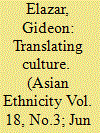

|
|
|
|
|
| Summary/Abstract |
In an attempt to emulate early modern missionaries to Yunnan who engaged in the invention of writing systems for various ethnic groups, contemporary evangelical missionaries in Yunnan have become heavily involved in the realm of linguistics, focused on the preservation of endangered languages. While such activity may potentially be perceived as a challenge to the state-Chinese linguistic hegemony, I argue that the presence of missionary linguists is acceptable to the Chinese authorities as it does not threaten the paramount position of Putonghua but rather serves to integrate minority people into the state system. In addition, based on interviews conducted with a missionary working to produce texts for Kunming’s Buoyi population in their language, I aim to demonstrate how missionary linguists attempt to remold local culture by attempting to reconstruct ethnic identity around a language core. The article is based on fieldwork conducted in Yunnan in 2009–2010 and 2012.
|
|
|
|
|
|
|
|
|
|
|
|
|
|
|
|
| 18 |
ID:
097889


|
|
|
|
|
| Publication |
2010.
|
| Summary/Abstract |
In this article, I reflect on a participatory learning and action (PLA) and participatory geographic information system (PGIS) project undertaken in two adjacent Hani villages in southern Yunnan, China. After a lengthy process to gain research authorisations, Hani villagers worked with a group of visiting researchers (Hani, Han Chinese and New Zealanders) to articulate local visions of land-use change and environmental challenges. PLA exercises produced a diverse range of hand-made and PGIS products over a 10-week period. As villagers became more accustomed to the 'outsider team', methods - both designed and spontaneous - diversified. Afterwards, based on the results and acting on their own initiative, local leaders backed by popular support moved quickly to reassert traditional and ritually prescribed Hani conservation measures. Nevertheless, these endogenously driven solutions were not necessarily universally beneficial. In describing the complexities encountered in implementing a participatory framework and the ambiguities of the outcomes engendered, I argue that privileging local coherence and celebrating such participatory approaches should not be done at the expense of ignoring the intricacies of on-going contradictory behaviours in a rapidly changing arena. Yet, in China, where authorities often remain suspicious of those seeking to undertake long-term fieldwork, especially among ethnic minorities, PLA offers a potential route forward.
|
|
|
|
|
|
|
|
|
|
|
|
|
|
|
|
| 19 |
ID:
053658
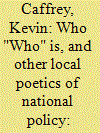

|
|
|
| 20 |
ID:
068750
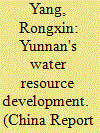

|
|
|
|
|
|
|
|